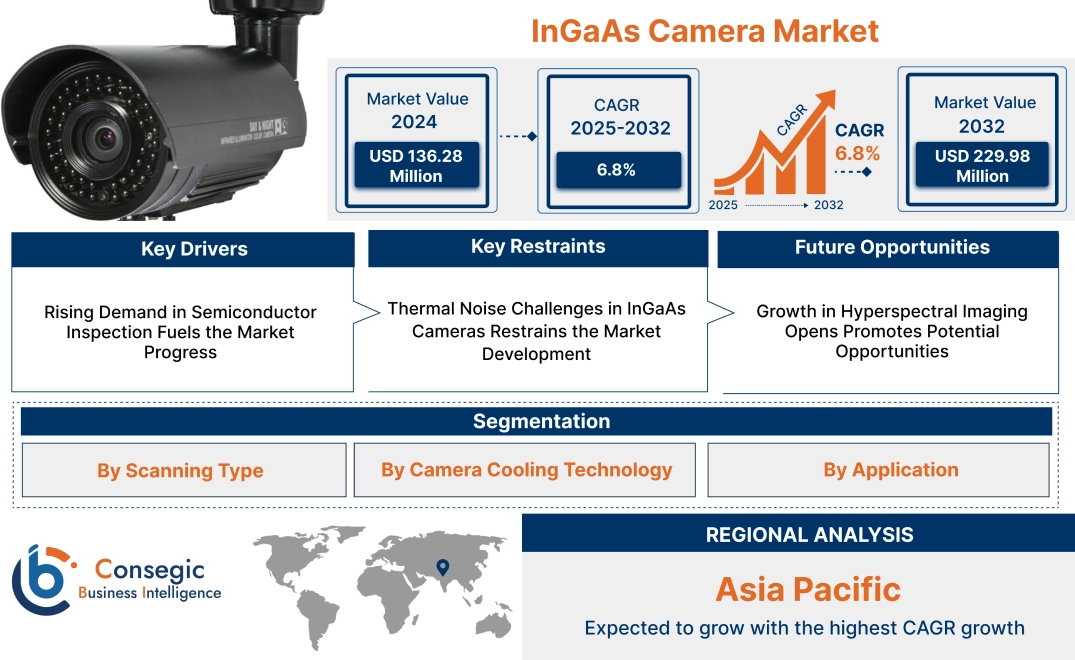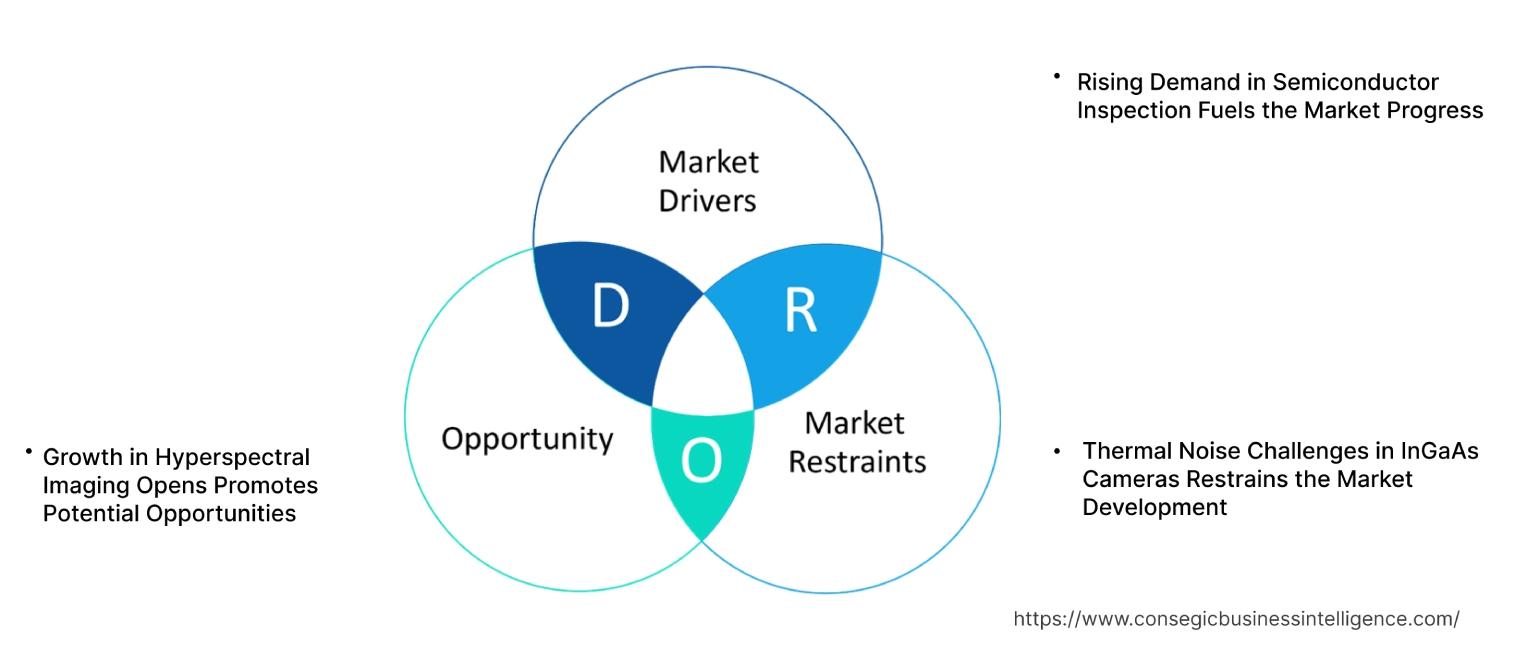InGaAs Camera Market Size:
InGaAs Camera Market size is estimated to reach over USD 229.98 Million by 2032 from a value of USD 136.28 Million in 2024 and is projected to grow by USD 143.06 Million in 2025, growing at a CAGR of 6.8% from 2025 to 2032.
InGaAs Camera Market Scope & Overview:
An InGaAs camera is a specialized imaging device that utilizes indium gallium arsenide (InGaAs) sensors to capture images in the shortwave infrared (SWIR) spectrum. These cameras are widely used for applications requiring high sensitivity in low-light conditions, such as industrial inspection, scientific research, defense, and medical imaging. The ability of these cameras to detect wavelengths beyond the visible spectrum makes them ideal for advanced imaging tasks.
These cameras are designed with features such as high frame rates, wide dynamic range, and compact designs to meet diverse operational needs. They are compatible with various imaging systems and are integrated into automated setups for enhanced functionality. They are known for their durability and precision, delivering reliable performance in challenging environments.
End-users of these cameras include industrial manufacturers, research institutions, and defense organizations, where high-precision imaging is critical for quality control, analysis, and security. These devices play a vital role in enabling advanced imaging capabilities across a wide range of specialized applications.
How is AI Transforming the InGaAs Camera Market?
AI is being integrated into InGaAs cameras to improve image analysis, pattern recognition, and automated decision-making, in turn leading to smarter imaging solutions. Moreover, AI integration in InGaAs cameras enhances their capabilities for tasks such as defect detection, classification, and pattern recognition, particularly in industrial inspection and security monitoring applications.
Additionally, AI algorithms can analyze images from InGaAs sensors in real-time, which further enables automation, improved accuracy, and faster decision-making. Thus, the above factors are projected to contribute to market growth during the forecast period.
InGaAs Camera Market Dynamics - (DRO) :
Key Drivers:
Rising Demand in Semiconductor Inspection Fuels the Market Progress
The semiconductor industry increasingly relies on high-precision imaging technologies for defect detection and wafer characterization, making InGaAs cameras essential tools. These cameras are particularly valued for their ability to detect defects, measure thickness, and analyze microchip structures with high precision in the shortwave infrared (SWIR) spectrum. As semiconductor manufacturers advance toward smaller and more complex nodes, the need for accurate and efficient inspection systems has intensified. The global surge in demand for microchips across industries such as consumer electronics, automotive, and telecommunications further boosts the adoption of these cameras. Their capability to operate in low-light conditions and deliver unparalleled accuracy makes them indispensable for maintaining quality and yield in semiconductor production. This trend aligns with the industry's focus on enhancing manufacturing efficiency while meeting the growing global demand for semiconductors, which further boosts the InGaAs camera market growth.
Key Restraints:
Thermal Noise Challenges in InGaAs Cameras Restrains the Market Development
InGaAs cameras, due to their low bandgap material, experience higher dark current compared to Si-CCD cameras. This thermally generated signal, or dark noise, reduces the signal-to-noise ratio, impacting image quality in sensitive applications. To mitigate these effects, these cameras require advanced cooling mechanisms, such as thermoelectric or cryogenic cooling, to maintain low operating temperatures. However, these cooling systems increase the complexity and cost of the cameras, limiting their accessibility for budget-sensitive industries. Additionally, the need for cooling introduces operational constraints, such as increased power consumption and potential maintenance issues, further restraining their adoption in portable or resource-limited applications. This thermal noise limitation poses a significant barrier for industries requiring high-precision imaging in challenging environments, hindering the InGaAs camera market demand.
Future Opportunities :
Growth in Hyperspectral Imaging Opens Promotes Potential Opportunities
The growth of hyperspectral imaging is significantly boosting the requirement for InGaAs cameras, as they excel in detecting subtle spectral differences beyond the visible spectrum. In agriculture, these cameras enable precision farming by identifying crop health, moisture levels, and nutrient deficiencies, ensuring optimal yields. In the mining industry, they assist in identifying mineral compositions and detecting valuable resources with high accuracy, reducing operational costs and improving efficiency. Additionally, these cameras are becoming indispensable in environmental monitoring, where they detect pollution levels, water quality variations, and atmospheric changes, supporting sustainability initiatives. Their ability to capture detailed spectral data across various applications positions them as a cornerstone technology in the hyperspectral imaging field, addressing critical needs across industries. With the increasing adoption of precision techniques in these sectors, the demand for these cameras is expected to grow substantially. Thus, the aforementioned factors are driving the InGaAs camera market opportunities.
InGaAs Camera Market Segmental Analysis :
By Scanning Type:
Based on scanning type, the market is segmented into area scan cameras and line scan cameras.
The area scan cameras segment held the largest revenue of the total InGaAs camera market share in 2024.
- Area scan cameras are widely adopted for applications requiring high-resolution imaging, such as surveillance and scientific research.
- Their versatility in capturing a complete frame at once makes them suitable for medical imaging and industrial quality control.
- These cameras are extensively used in safety-critical environments, where precise and detailed imaging is essential.
- Thus, as per the market trends, the dominance of this segment is driven by increasing deployment in sectors like defense and healthcare for high-accuracy imaging solutions, contributing to the InGaAs camera market expansion.
The line scan cameras segment is projected to grow at the fastest CAGR during the forecast period.
- Line scan cameras are ideal for continuous imaging in high-speed environments such as manufacturing and production lines.
- Their efficiency in capturing images for industrial automation and inspection applications is driving adoption.
- The compact design of these cameras makes them suitable for space-constrained environments like semiconductor fabrication units.
- As per the InGaAs camera market analysis, the rapid adoption of line scan cameras is supported by advancements in automation and industrial robotics.
By Camera Cooling Technology:
Based on camera cooling technology, the market is segmented into cooled InGaAs cameras and uncooled InGaAs cameras.
The cooled InGaAs cameras segment held the largest revenue of the total InGaAs camera market share in 2024.
- These cameras are used in applications requiring minimal thermal noise, such as medical imaging and scientific research.
- The advanced cooling systems ensure high sensitivity and precise imaging in challenging environments.
- Cooled cameras are extensively employed in aerospace and defense sectors for target detection and reconnaissance missions.
- As per the InGaAs camera market trends, the dominance of this segment is driven by the growth in the need for high-performance imaging in extreme operating conditions.
The uncooled InGaAs cameras segment is expected to grow at the fastest CAGR during the forecast period.
- Uncooled cameras are cost-effective alternatives, making them suitable for widespread industrial and commercial applications.
- Their simplified design and low maintenance requirements support the adoption in surveillance and safety systems.
- These cameras are increasingly integrated into automation processes, particularly in industries like manufacturing and logistics.
- Therefore, the segment’s growth is fueled by innovations in uncooled camera technology, enhancing image quality without cooling mechanisms, driving the InGaAs camera market growth.
By Application:
Based on application, the market is segmented into military & defense operations, industrial automation, surveillance, safety & security, scientific research, and others.
The military & defense operations segment accounted for the largest revenue of 32.2% share in 2024.
- InGaAs cameras are critical for target detection, night vision, and missile guidance systems in defense applications.
- The ability to operate effectively in low-light and extreme conditions makes them indispensable in combat and reconnaissance missions.
- Governments across the globe are investing in advanced imaging solutions to enhance military capabilities.
- As per the InGaAs camera market analysis, the dominance of this segment is supported by the growing use of these cameras in border surveillance and threat detection.
The industrial automation segment is expected to grow at the fastest CAGR during the forecast period.
- These cameras are increasingly utilized in automated inspection systems to improve manufacturing efficiency and reduce defects.
- Their integration with industrial robots enhances process accuracy and operational reliability.
- The rising adoption of smart factories and IoT-driven automation supports the expansion of this segment.
- As per the market trends, the segment’s growth is driven by technological advancements in camera sensors, enabling high-speed and precise imaging for industrial use, which further facilitates the InGaAs camera market demand.
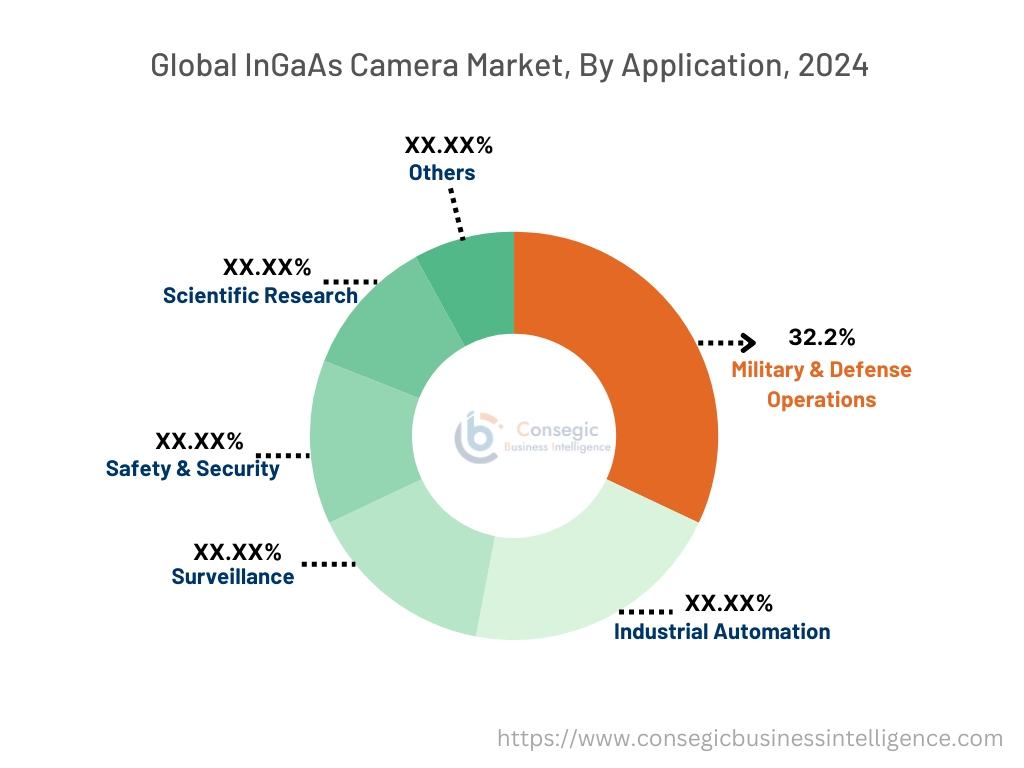
Regional Analysis:
The regions covered are North America, Europe, Asia Pacific, the Middle East and Africa, and Latin America.
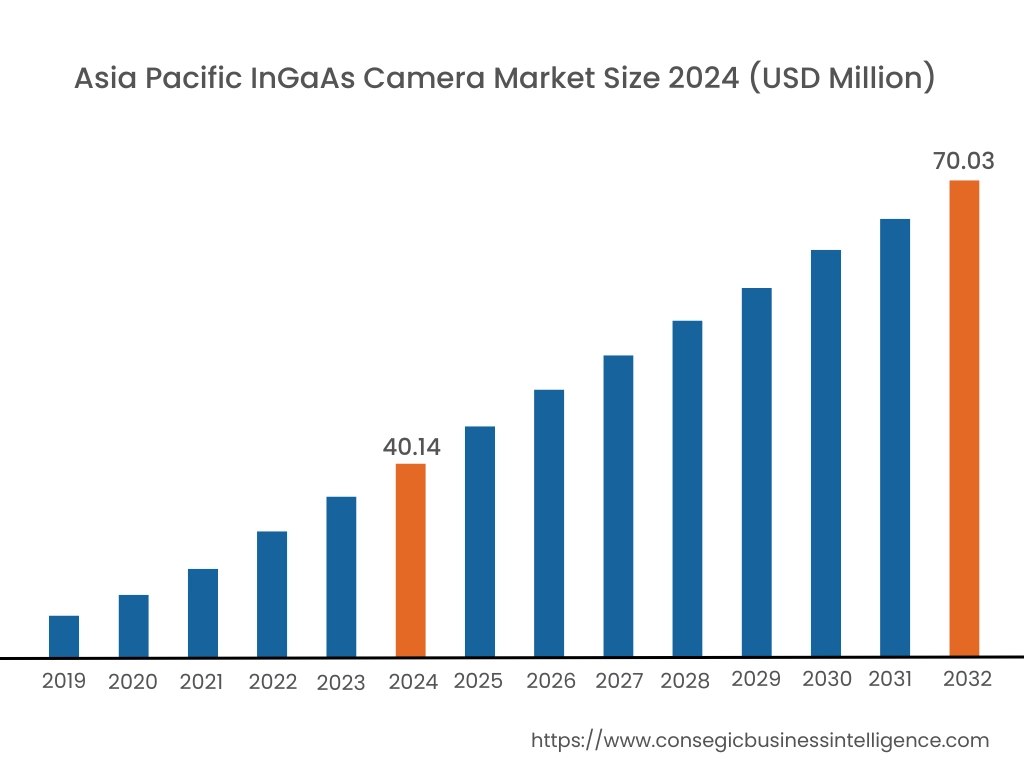
Asia Pacific region was valued at USD 40.14 Million in 2024. Moreover, it is projected to grow by USD 42.25 Million in 2025 and reach over USD 70.03 Million by 2032. Out of this, China accounted for the maximum revenue share of 32.1%. The Asia-Pacific region is experiencing rapid development in the InGaAs camera market, driven by industrialization and technological advancements in countries such as China, Japan, and South Korea. The expansion of the consumer electronics sector and the rising demand for high-performance imaging solutions have intensified the need for advanced imaging technologies. Government initiatives promoting industrial efficiency further influence InGaAs camera market opportunities.
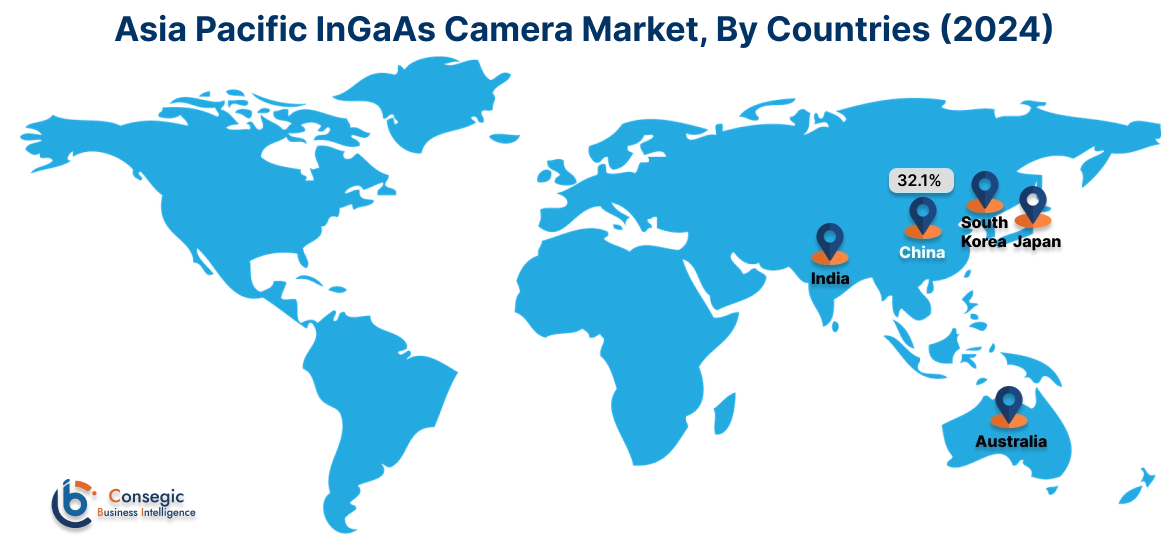
North America is estimated to reach over USD 74.54 Million by 2032 from a value of USD 45.21 Million in 2024 and is projected to grow by USD 47.36 Million in 2025. This region holds a significant share of the InGaAs camera market, driven by the increasing adoption of advanced imaging solutions in sectors such as defense, industrial automation, and scientific research. The United States, in particular, has seen a rise in the implementation of these cameras for applications requiring sensitivity to near-infrared wavelengths. A notable trend is the integration of cameras in machine vision systems to enhance quality control and inspection processes. The analysis of InGaAs camera market trends indicates that the presence of key market players and continuous technological advancements contribute to the region's market dominance.
Europe represents a substantial portion of the global InGaAs camera market, with countries like Germany, France, and the United Kingdom leading in adoption and innovation. The region's emphasis on sustainability and energy efficiency has propelled the utilization of eco-friendly imaging solutions. Analysis indicates a growing trend towards the deployment of InGaAs cameras in various applications, offering flexibility across multiple sectors.
The Middle East & Africa region shows a growing interest in advanced imaging solutions, particularly in the telecommunications and industrial sectors. Countries like the United Arab Emirates and South Africa are investing in modern technologies to enhance data acquisition capabilities and comply with international standards. Analysis suggests an increasing trend towards adopting InGaAs cameras to meet the needs of modern imaging applications.
Latin America is an emerging market for InGaAs cameras, with Brazil and Mexico being key contributors. The region's growing focus on technological modernization and the automotive sector has spurred the adoption of advanced imaging solutions. Government policies aimed at enhancing technological capabilities influence InGaAs camera market expansion.
Top Key Players and Market Share Insights:
The InGaAs Camera market is highly competitive with major players providing products and services to the national and international markets. Key players are adopting several strategies in research and development (R&D), product innovation, and end-user launches to hold a strong position in the global InGaAs Camera market. Key players in the InGaAs Camera industry include -
- Hamamatsu Photonics (Japan)
- Sensors Unlimited (a division of Collins Aerospace) (USA)
- Teledyne DALSA (Canada)
- FLIR Systems (USA)
- New Imaging Technologies (NIT) (France)
- Allied Vision Technologies GmbH (Germany)
- Raptor Photonics (UK)
Recent Industry Developments :
Product Launches:
- In July 2024, NIT launched the SenS 1920, a Full HD resolution SWIR camera featuring ultra-low noise (25e-), 1920×1080 resolution, an 8μm pixel pitch, and a dynamic range of 64dB. Equipped with NIT’s proprietary InGaAs NSC2101 sensor, the camera covers a wavelength range of 900nm–1700nm and supports >40Hz frame rates via USB 3.0. Ideal for ISR and semiconductor inspection, it combines high precision with plug-and-play usability for advanced imaging needs.
InGaAs Camera Market Report Insights :
| Report Attributes | Report Details |
| Study Timeline | 2019-2032 |
| Market Size in 2032 | USD 229.98 Million |
| CAGR (2025-2032) | 6.8% |
| By Scanning Type |
|
| By Camera Cooling Technology |
|
| By Application |
|
| By Region |
|
| Key Players |
|
| North America | U.S. Canada Mexico |
| Europe | U.K. Germany France Spain Italy Russia Benelux Rest of Europe |
| APAC | China South Korea Japan India Australia ASEAN Rest of Asia-Pacific |
| Middle East and Africa | GCC Turkey South Africa Rest of MEA |
| LATAM | Brazil Argentina Chile Rest of LATAM |
| Report Coverage |
|
Key Questions Answered in the Report
What is the size of the InGaAs Camera Market? +
InGaAs Camera Market size is estimated to reach over USD 229.98 Million by 2032 from a value of USD 136.28 Million in 2024 and is projected to grow by USD 143.06 Million in 2025, growing at a CAGR of 6.8% from 2025 to 2032.
What are the key drivers of the InGaAs Camera Market? +
The key driver is the rising demand in the semiconductor industry, where InGaAs cameras are essential for defect detection, wafer characterization, and microchip analysis in the shortwave infrared (SWIR) spectrum. Additionally, the growth of the semiconductor industry, driven by sectors such as consumer electronics, automotive, and telecommunications, further accelerates the adoption of these cameras.
What are the key segments of the InGaAs Camera Market? +
The market is segmented by scanning type (area scan and line scan cameras), camera cooling technology (cooled and uncooled InGaAs cameras), and application (military & defense, industrial automation, surveillance, scientific research, and others). Each segment caters to specific imaging needs in industries such as defense, healthcare, and automation.
Who are the leading players in the InGaAs Camera Market? +
Leading players in the market include Hamamatsu Photonics (Japan), Sensors Unlimited (USA), New Imaging Technologies (France), Allied Vision Technologies GmbH (Germany), Raptor Photonics (UK), Teledyne DALSA (Canada), and FLIR Systems (USA).
